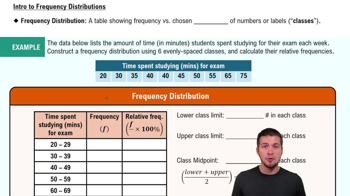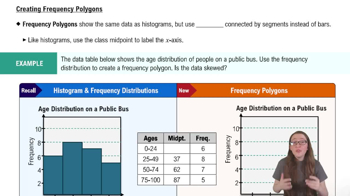Here are the essential concepts you must grasp in order to answer the question correctly.
Frequency Distribution
A frequency distribution is a summary of how often each value occurs in a dataset. It organizes data into classes or intervals, showing the number of observations (frequency) that fall within each class. This helps in understanding the distribution of data points and identifying patterns or trends.
Recommended video:
Intro to Frequency Distributions
Classes and Class Width
Classes are the intervals into which data is grouped in a frequency distribution. The class width is the range of values that each class covers, calculated by subtracting the lower limit of a class from its upper limit. Choosing an appropriate number of classes and class width is crucial for accurately representing the data.
Recommended video:
How to Create Frequency Distributions Example 2
Frequency Polygon
A frequency polygon is a graphical representation of a frequency distribution. It is created by plotting the midpoints of each class against their corresponding frequencies and connecting these points with straight lines. This visual tool helps to easily identify trends and the overall shape of the data distribution.
Recommended video:
Creating Frequency Polygons
 Verified step by step guidance
Verified step by step guidance Verified video answer for a similar problem:
Verified video answer for a similar problem:



 4:41m
4:41m